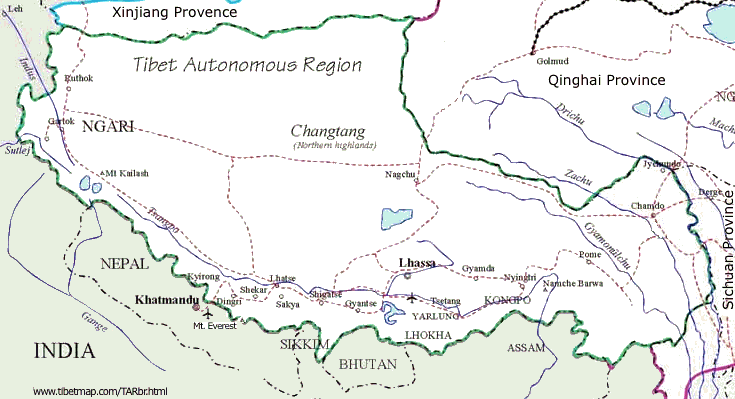   
Xizang Zizhiqu (XZ) - Tibet Autonomous Region (TAR) of China

Zoom out to China | Lhasa to Katmandu map | Himalaya
Tibet Information
In his introduction to the Sierra Club Tibetan Odyssey Trip, Partick Colgan states:
"There are many names for Tibet: the Forbidden Kingdom, Shangri-La, the Land of
Snows, the Mystic Realm, the Hidden Kingdom on the Rooftop of the World.
However, I call it the "Jewel in the Ice." Isolated for centuries from the
outside world by imponderable barriers of towering rock and ice, Tibet's cold
and dusty plateau, with its ancient Buddhist kingdoms and monastic
institutions, had long been prized by explorers, cartographers, demographers,
political and military strategists, and empire builders alike."
Tibet is in the Southwestern part of China. It's
border with Nepal runs along the center of
the Himalayan Mountains.
It consists of 7 prefecture's.
History:
Not until the 7th century can
Tibetans be recognized as a race of people. The rising Yarlung Dynasty (Tubo
Kingdom) unified Tibet and became an aggressive power. Inter-court marriages
were adopted for political reasons. Nepal and China married their Princesses to
Songtsen Gampo, the outstanding king of Tibetan people. The two Princesses
brought with them peace and also Buddhism which Tibetans readily converted to.
The great religious teacher, Padmasambhava was invited to Tibet and Buddhism was recognized as the state religion.
In the 13th century Tibet became an appendage of the Mongol Empire.
In the 15th century, the rise to power of the Gelugpa order of monks, whose lamas were believed to be reincarnations of their predecessors.
The great fifth Dalai Lama assumed power within Tibet, which was pacified with Mongol backing by 1656.
A series of Mongol invasions started in 1705.
They were finally ousted by the Chinese, who were received as liberators by the Tibetans, and Emperor Kang Xi declared Tibet a protectorate of China - a historical precedent for the Communist takeover nearly 250 years later.
A Chinese military intervention took place in reaction to a Gurkha invasion from Nepal in 1788. From this time Manchu influence in Tibet receded.
In 1903-1910 the British signed several accords with Tibet, after the Dalai Lama had fled to Mongolia with a Russian 'adviser'.
In 1924 George Mallory and Andrew Irvine attempted to climb Mt. Everest from the Tibet side. They died in the attempt. See Everest.
In 1910, with the Manchu Qing Dynasty teetering on the verge of collapse, the Manchus invaded Tibet, driving the Dalai Lama once again into flight.
In 1911 a revolution in China toppled the Qing dynasty and the following year the last of the Manchu forces were sent back to China. In 1913 the 13th Dalai Lama returned to Lhasa. For the next 30 years, Tibet enjoyed freedom.
The present (14th) Dalai Lama was installed as the Dalai Lama in 1940.
In 1950, Mao Tsetung's Peoples Liberation Army (PLA) invaded Tibet and it
was closed to foreign visitors. The Dali Lama's government tentatively agreed
to cooperate with the Chinese. The people continued to resist Chinese control
and after large scale fighting broke out in 1959 the Dali Lama fled to India.
In 1965, the Tibet Autonomous Region was founded.
During the Cultural Revolution of 1966 to 1969, Chinese and Tibetan Red Guards
shut down, looted, destroyed many monasteries.
Before 1959, there were more than 2,500 monasteries, but only 70 remained after
'democratic reform' - a reduction of more than 97 percent by 1962.
Over the same period, the number of 110,000 monks and nuns fell by 93 percent to only 7,000.
In 1978, China allowed
Tibetans in exile to return freely (the only condition being that on their visa
applications they gave their nationality as Chinese.)
In 1980 it was opened
to foreign visitors, but tourists must be in groups (usually 4 or more)
approved by the Chinese Government.
By the late '80s, the Chinese government said there were over 200 functioning monasteries
The traditional way of life of the
Tibetan people has been somewhat modernized. A sample survey in 2002 showed that for
every 100 urban households, there are 212 bicycles, 88 color televisions, 84
radio cassette recorders, 42 washing machines, 24 refrigerators and 26 cameras.
In 2006 china finished railroad line connecting Beijing and Lhasa.
China says the 1,140km (710-mile) line will bring major opportunities to a poor region.
But critics fear it will be used by China to assert its control over a contested border region.
They also say the railway line threatens not only the delicate Himalayan environment, but also the ancient Tibetan culture.
In the spring of 2008, prior to the 2008 Olympics to be held in Beijing, monks staged a march through Lhasa to mark the anniversary of the 1959 uprising. It grew into a full-scale clash between Tibetans and police and spread to neighboring Sichuan, Qinghai and Gansu provinces.
The Dalai Lama decried what he called the "cultural genocide" taking place in his homeland.
After the first two weeks or unrest the Tibetan government in exile in the northern India said that about 140 Tibetans have been killed, but the Chinese government has not issued any figures.
Tibet Info at:
History at Lonley Planet.
Magellan's,
Travel China Guide, Google, Yahoo, Rec.travel library, Lonely Planet
,
Place Names for Chinese characters and alternate spellings.
Trips (Tibetan Odyssey, ...) Sites (Everest, ...).
China Information
The Dali Lama at wikipedia
More >
Travel Help:
China at travel.state.gov
U.S. embassy consulate office in Chengdu China covers the southern part of China
Tel: (86-28) 8558 3992, 8558 9646
Email: consularchengdu@state.gov
Books:
The Open Road: The Global Journey of the Fourteenth Dalai Lama
Links:
climb Mt. Everest
China
Return to Places.
last updated 25 Mar 2008
|  Places
Places
 China
China

 - Tibet -
- Tibet - 
 Places
Places
 China
China

 - Tibet -
- Tibet - 